We first start our discussion on Adrenal Fatigue Syndrome (AFS) and reproductive system function by going through some of the basic sciences involved by looking at the fertility process and reproductive system function first. It is first controlled by the hypothalamus through a series of hormones including LH and FSH, and the body’s response through the pituitary system and through the ovarian systems follows accordingly. The basic hormones responsible for reproduction and the reproductive system function and for making women feel good are estrogen and progesterone. Now estrogen we use as a term to indicate a family of hormones which includes E1, E2, and E3, which we will go into later, but we will lump them all together and call them estrogen for now.
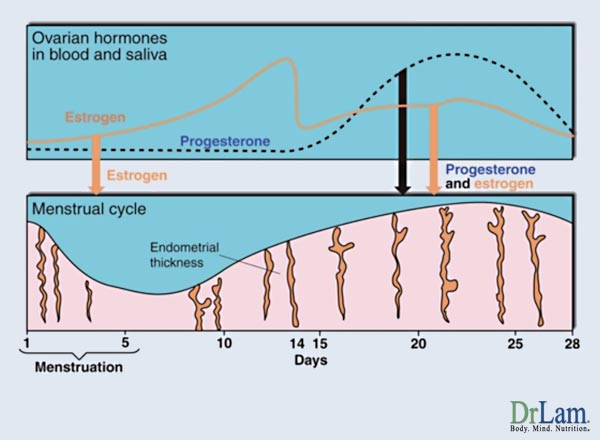
Now, as you can see above, the key diagrams here are number 3 and number 4, and they show the normal reproductive menses. Now, Day 1 is when menstruation begins, and then going through a cycle of 28 days. The uterine lining sloughs off from Day 1 to Day 5, which is what we call the menses, and then after that, it regenerates itself until ovulation occurs on Day 14, and if fertilization does not occur, the endometrial lining will be sloughed off again resulting in the menses.
The key things to look at in the reproductive system function here is that ovulation occurs on Day 14, the pre-ovulation phase is from Day 1 to Day 14, and the post-ovulation phase is from Day 14. The responsible hormones for this reproductive system function include estrogen and progesterone. As you can see here, the estrogen level usually starts to rise from menstruation (day 1) and hits a peak around Day 14. If fertilization occurs during the ovulation period, then the graph will reflect this accordingly, but if there is no fertilization, then the estrogen level will gradually go down until the menses starts on Day 28. In the meantime, the progesterone level tends to rise around Day 14 and goes up in the 20-30 day cycles and without the reproductive system function of fertilization there's no need for the progesterone to be there because there’s no fetus to support, and therefore the progesterone level goes down as the resulting menses comes on.
What is important to understand in this basic diagram is that estrogen and progesterone need to be maintained at a very fine balance throughout the menstrual cycle for proper reproductive system function. In other words, if your estrogen level and progesterone level are off, then problems in the reproductive system function can arise. Additionally, if the absolute levels are within the range, but they’re off balance relative to one another (a relative increase or relative deficiency of either estrogen or progesterone), then the hormonal cycle can be disrupted; we will talk about that more later.
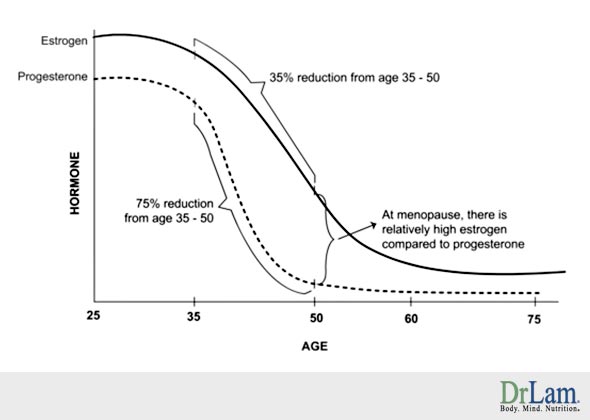
Taking a step back now and looking at this diagram above, you can see that women during reproductive ages from 25-50, and then postmenopausal onwards, have a very fine estrogen/progesterone balance that we mentioned before. However, if you look at the overall picture, there’s this reduction of estrogen over time as one approaches menopause. Progesterone also has a reduction. The problem with most women's reproductive system function is that in most cases the decline in progesterone is far greater than the decline in estrogen. As a result, as a person goes through teens, young adulthood, and even adulthood into menopause, the tendency is for a condition called estrogen dominance to arise, whereby the drop in estrogen is relatively small compared to the drop in progesterone. As a result, you have a relative increase in estrogen. In other words, the estrogen drops, as well as the progesterone drops, while they are within normal ranges on an absolute basis, the end results is a relative increase of estrogen in the body. Now, this is very disruptive and leads to many conditions in the reproductive system function, which we will discuss later, but suffice to say that the estrogen/progesterone ratio is very important to be maintained. If this ratio is not maintained, then problems will occur in the reproductive system function and other areas.
The major reproductive system function disruption exhibited in modern society is this condition called estrogen dominance we just referred to. Now, this is very serious because it actually starts quite early on, even in the teens, but it is rarely noticed. Remember, we said earlier that estrogen dominance is when you have excessive amounts of estrogen relative to progesterone, not on an absolute basis but on a ratio basis. So the question is, “What are things that disrupt this ratio and lead to an increase of estrogen on a relative basis?” There are many things we need to consider with reproductive system function. In addition to exogenous estrogen such as the intake of estrogenic compounds in the form of hormones, we are all exposed to environmental estrogen, or what we call xenoestrogens. These are chemical compounds that are structurally similar to estrogen, so when they enter the body, they behave with estrogenic effect on the reproductive system function. Examples are certain plastics, chemicals that are petroleum related because their chemical molecular structures are quite similar. Remember that cholesterol is the mother of estrogenic hormones, and petroleum oil rings are very similar in structure.
It is important to back up and understand that estrogen is a pro-growth hormone. It causes the endometrium to proliferate, it causes breast stimulation that leads to menarche, it increases body fat, it increases endometrial cancer risk, and it restrains the osteoclasts. Progesterone is the balancer of estrogen in terms of the reproductive system function, and it does many things on the opposite side. In other words, it maintains the secretory endometrium, it protects against fibrocystic breast, it helps to prevent breast cancer, it helps to use fat for energy, and it helps to prevent endometrial cancer. So in the body, the estrogen and progesterone are always in a perfect balance for the reproductive system function, but when you offset this balance, problems begin.
 Symptoms of estrogen dominance can include the following:
Symptoms of estrogen dominance can include the following:
These are all part of the continuum of estrogen dominance that are exhibited in the body and the reproductive system function, usually over a long period of time, starting in the teens with PMS, advancing to fibrocystic breast disease and PCOS during college days and young adulthood, and eventually, fibroids, severe endometriosis, and breast cancer.
In addition to what we learned earlier about environmental estrogen, it is very important to know that the estrogen level in our body is also regulated by two other organ systems. One system is the adrenal glands and the adipose tissue. In other words, the estrogen level increases in the body when the adrenal glands are stressed because that is how estrogen is made. At the same time, those who are overweight have a tendency to have more adipose tissue, which leads to more estrogen secretion for reproductive system function. Coffee and other dietary factors can also increase estrogenic production in the body. So, multiple things contribute to a higher level of estrogen including the environment, lifestyle, our intrinsic ability to handle stress, the adrenal glands, and adipose tissue.
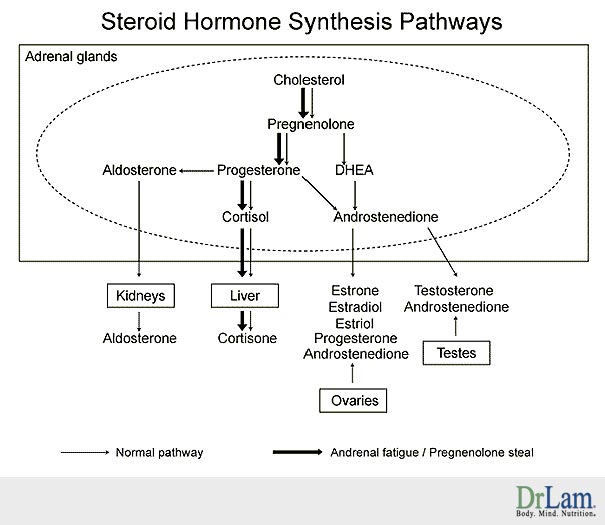
Now that you understand how the estrogen and progesterone levels are balanced in the body for the reproductive system function, both in the ovaries as well as being made in the adipose tissues, we now have to focus on the adrenal system. The adrenal glands are the hormonal system glands that are responsible for synthesizing many of the hormones used in the body. Starting from cholesterol as a building block, it makes a prohormone called pregnenolone (the mother of all hormones), from which many other hormones are made. Pregnenolone, as you can see, is made into progesterone, which then is made into cortisol.
Additionally, pregnenolone is also made into DHEA as well as other male hormones, some of which are turned into estrogen. In other words, with this simplified diagram, the lesson to take home is this: if your adrenal glands are working properly, your progesterone level will be well balanced with the estrogen family (E1, E2, and E3), which are estrone, estradiol, and estriol.
When your body is stressed, the adrenal glands are put into overdrive to deal with the stress, and then the body tends to put out more cortisol in order deal with said stress, because the cortisol is the ultimate anti-stress hormone. In this process, pregnenolone is used up to make more cortisol in a concept known as “pregnenolone steal.” In other words, the body uses more cholesterol to make pregnenolone, but that extra pregnenolone, instead of sticking around, is being used to make more progesterone with the ultimate goal of making more cortisol. The problem is that, in the process, the precursor hormones such as pregnenolone and progesterone can be depleted. In the case of progesterone, if it is depleted in this process as the adrenal glands are put on overdrive to make cortisol, then you have less opposing progesterone in the body to offset estrogen. This results in the estrogen dominance that we referred to earlier.
Therefore, anything that stresses the adrenal glands has a potential to reduce progesterone output, leading to an increase in estrogen output. This is why we often see that in people with Adrenal Fatigue Syndrome (AFS), the tendency is for them to have estrogen dominance symptoms such as PMS, endometriosis, the irregular menses, fibrocystic breast disease, as well as fibroids. The severity of the symptoms will go up in advanced cases, as the adrenal glands approach a near-failure stage. A separate mechanism will then kick in where the body shuts down, resulting in amenorrhea. That’s why many people, even young people, if they try to exercise too much and start training for excessive exercise programs such as a marathon or ultramarathon, will have their body’s menstrual cycle shut down for a period of time during said training. This reflects the body’s way of survival because it feels fatigue and pregnancy is low priority in a time that it perceives as being stressful.
Now, let’s take a look at what happens when estrogen dominance becomes very severe. In the body, when you have an adrenal system that’s out of balance because of stress as we talked about earlier, whether it is because a person is involved in excess exercise, very stressful schoolwork, a stressful career advancement, or even relationship difficulty, the adrenal glands will kick into overdrive, resulting in an increased level of estrogen circulating in the body. Now, advanced Adrenal Fatigue Syndrome causes another set of problems in the sense that estrogen dominance is also related to the ovarian system as well as the thyroid system through the Ovarian Adrenal Thyroid (OAT) axis as you can see here.
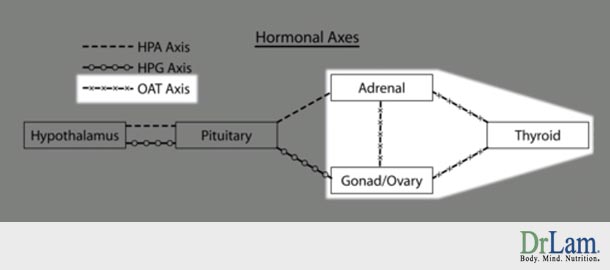
In other words, the hormonal systems in the body and the reproductive system function are not singly independent. Instead, they are all tied together with networks, and one of the key networks is the Ovarian Adrenal Thyroid axis. What happens to the adrenal system will affect the ovarian system and reproductive system function, and what happens to the ovarian system and reproductive system function will affect the thyroid system. It’s like three legs of a stool. When one is disrupted, whether it is a thyroid problem, a low adrenal function problem, or an ovarian problem, then the other two systems are invariably affected. The key to balancing hormones properly in women is to look at all three at the same time and see what we can do to simultaneously nurture the systems back and rebalance all three at the same time. If the emphasis is just to balance one of the three, for example the estrogen level, without looking at the thyroid or the adrenal glands, then this will usually fail.
Now let’s take a step back and look at what we see clinically. A typical patient will come in, in their mid-teens, late teens, or early young adulthood complaining of problems with irregular menses, periods that are somewhat disruptive in nature (longer or shorter than normal), stress related acne that can be worsened by a lot of sugar intake, and severe PMS. Usually, the doctors do a complete workup and find that things are okay at the pituitary and the hypothalamic levels, and so these people are put on either hormones or birth control pills in various forms. If the diagnosis is mild endometriosis or a mild type of PCOS and if the PCOS is severe, then the common recommendation is to put them on insulin regulating drugs like metformin. If it was found that the thyroid is the problem then usually the patient is started on thyroid medication and thyroid support of one kind or another. So, the conventional medicine approach is to look at each one of these symptoms. If it’s a thyroid problem, then they will fix it with thyroid medication. If it’s an ovarian system problem, then they will fix it with bioidentical or regular hormone replacement.
Very little attention is actually paid to the adrenal system. However, we know that this is not the most comprehensive way because until you fix the adrenal glands, you are not going to be able to really balance the system of female hormones. As a result, many people go into long trials of birth control, thyroid stimulations, and bioidentical hormonal replacement, but they never really can get a good balance. they sometimes feel slightly improved, but the PCOS continues, the irregular menses continue, and fertility becomes a big issue.
 Why is it a big issue? It’s because the body is decompensating over time, and this can take anywhere from a few years to a decade. This is because when the hormones are not well balanced, the body is under stress, and it draws on its reserves. When the reserves start to run out, then the body becomes fatigued. The body's way of preserving itself when it’s faced with fatigue and reduced energy output is to slow down the body even more in order to conserve what it has. As a result, fatigue, tiredness, and lethargy become more prominent, and this can then, in turn, lead to compensatory activation of the neuroendocrine system to release adrenaline and norepinephrine in order to stimulate the body to increase energy supply as a last resort. When that happens, the body enters into what we call a wired and tired state where centrally at the nervous system, it is excitatory, however, the peripheral nervous system is being slowed down; For example, the person cannot sleep because they are wired, but at the same time, they are tired throughout the day’s activities.
Why is it a big issue? It’s because the body is decompensating over time, and this can take anywhere from a few years to a decade. This is because when the hormones are not well balanced, the body is under stress, and it draws on its reserves. When the reserves start to run out, then the body becomes fatigued. The body's way of preserving itself when it’s faced with fatigue and reduced energy output is to slow down the body even more in order to conserve what it has. As a result, fatigue, tiredness, and lethargy become more prominent, and this can then, in turn, lead to compensatory activation of the neuroendocrine system to release adrenaline and norepinephrine in order to stimulate the body to increase energy supply as a last resort. When that happens, the body enters into what we call a wired and tired state where centrally at the nervous system, it is excitatory, however, the peripheral nervous system is being slowed down; For example, the person cannot sleep because they are wired, but at the same time, they are tired throughout the day’s activities.
Now, usually by this time the patients will have seen multiple doctors. They are probably on thyroid medication to stimulate their energy supply because the emphasis is on energy by the time this disruptive process progresses to this stage. They can be on birth control pills as well. Those who see a naturopathic professional might be put on natural stimulants, which are not far away from thyroid type medicine in principle, in terms of metabolic stimulation. However, all of these actually increase estrogen dominance because they tend to stimulate the adrenal glands more than what they are capable of delivering. As you can see, when you try to stress the adrenal glands, the progesterone levels tend to go down, resulting in worsened estrogen dominance. As the estrogen dominance worsens, which was the initial trigger for problems such as PMS, fibrocystic breast disease, endometriosis, irregular menses, and fibroids, the symptoms actually get worse. A person just seems to have a tough time managing these symptoms, and the more they try to patch up the symptoms, the worse they get. The reason is that they are not factoring in all three components of the OAT axis (the adrenal glands, thyroid, and the ovarian system), but are only focusing on one or two.
As this goes on, what happens is that when it comes time for reproduction, the first problem a person faces is infertility. If the estrogen dominance, OAT axis imbalance, and adrenal fatigue are severe, then the body will shut down and the person will have amenorrhea (lack of menstrual cycles). However, not many people are in that stage, especially when they are still young in their mid-20s to mid-30s. So, the first sign of a problem, in addition to PCOS, endometriosis, and PMS, is infertility.
 The person has a hard time getting pregnant because ovulation is difficult, and implantation is difficult. Many people end up doing in vitro fertilization (IVF), as well as multiple attempts to get pregnant, but each time they are met with failure. Usually, many tries are necessary in order to have success. In other words, the body is not quite ready and is sending a signal that it does not want to get pregnant, which is why fertility becomes a challenge. This is a subtle sign that most people just disregard. They think that this is just something that can be overcome with IVF, and they start planning for IVF.
The person has a hard time getting pregnant because ovulation is difficult, and implantation is difficult. Many people end up doing in vitro fertilization (IVF), as well as multiple attempts to get pregnant, but each time they are met with failure. Usually, many tries are necessary in order to have success. In other words, the body is not quite ready and is sending a signal that it does not want to get pregnant, which is why fertility becomes a challenge. This is a subtle sign that most people just disregard. They think that this is just something that can be overcome with IVF, and they start planning for IVF.
Sometimes they may get lucky and ovulation occurs, then implantation occurs and they become pregnant; these are the lucky few and usually have a relatively strong constitution or are still relatively young, and their body is able, with the last resort, to still go through pregnancy and fertilization of the egg despite a dysfunctional and imbalanced OAT axis.
Bear in mind that not everybody is on thyroid medication or antidepressants, which conventional doctors often give when they run out of options. Not everybody is on a lot of medication, but a lot of them cannot figure out what is going on. The pregnancy becomes a problem, because they keep trying and trying, thinking that after an extensive workup – in which they were told that everything is fine at the hypothalamus as well as the pituitary gland – that they are just unlucky, so to say.. Even so, after years of trying, some people eventually get pregnant. Of course, they are overcome with joy, and they start to think they have overcome the problem.
As you remember, earlier we talked about the progesterone level being reduced when you have severe adrenal fatigue. In the first trimester of pregnancy, progesterone is an absolutely necessary hormone in order to maintain the fetus. If you don’t have enough progesterone in the body, then the tendency is for miscarriages to occur. This usually happens anywhere from week 6 or 7, all the way up to the late first trimester. So, despite the initial happiness, those people who have OAT axis imbalance, as well as adrenal fatigue and pregnancy, will invariably find themselves having some miscarriages, usually during the late first trimester. This can happen one time, and then two times, and three times; and some people will come to us with 5, 6, or even 7 serial miscarriages usually happening in the late first trimester. But the question is, why?
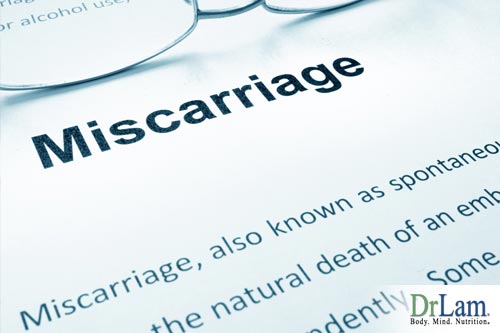 The answer is quite obvious if you understand the physiology. It’s that the body simply will not allow the fetus to carry into the second and third trimesters because it is unable to come up with an adequate amount of progesterone. Now, an astute obstetrician can sometimes pick this up, and then give a natural progesterone supplement during the first trimester. This is good, but by and large, this is usually missed until after many miscarriages because people don't think about this, because physicians don't think of the general picture of stress, of the thyroid involvement or the adrenal dysfunction when a young, otherwise healthy woman comes into the office after just having a miscarriage.
The answer is quite obvious if you understand the physiology. It’s that the body simply will not allow the fetus to carry into the second and third trimesters because it is unable to come up with an adequate amount of progesterone. Now, an astute obstetrician can sometimes pick this up, and then give a natural progesterone supplement during the first trimester. This is good, but by and large, this is usually missed until after many miscarriages because people don't think about this, because physicians don't think of the general picture of stress, of the thyroid involvement or the adrenal dysfunction when a young, otherwise healthy woman comes into the office after just having a miscarriage.
The tendency is to treat it as an isolated event and ask the patient to try again. Then if that fails, the natural progression is to proceed to very expensive IVF, when in fact we should be looking at adrenal dysfunction as a possible cause of the miscarriages. So the alarm is this; if a person has repeated miscarriages in the first trimester, especially the late first trimester, you have to think of adrenal fatigue. If you don’t, it will happen again and again. The good news, on the other hand, is that if you do support the adrenal glands, then this usually results in a happy ending for everybody.
We have now covered two aspects: infertility that is due to estrogen dominance and OAT axis imbalance, and that when you are able to get pregnant, serial miscarriages are a warning sign of underlying worsening estrogen dominance and OAT axis imbalance in the setting of stress and the adrenal fatigue. Now, some are fortunate enough to be able to get pregnant as well as go through the first trimester, and they are relatively home free in terms of keeping baby after that.
So, this is good news, but then the question becomes, “Well, how does the person go through the rest of the pregnancy?” and there are two general pictures that can emerge. Now, if a person has adrenal fatigue, then the body is trying to put out more progesterone during the pregnancy. Sometimes the body is successful in doing that, especially if the person is young and constitutionally strong. So during pregnancy, the woman will feel very good, and in fact, most of them will report looking back at this as the best time of their life. They love to get pregnant and they want to get pregnant again just to experience that moment of bliss, because the body is able to put out sufficient progesterone not only to overcome the progesterone deficiency that is common in OAT axis imbalance and estrogen dominance, but the extra progesterone also causes a calming effect for them, and overcomes their fatigue. Now, unfortunately, this does not happen too often.
 However, there’s another group of people who, even though they make it through the first trimester, have a terrible time in the second and the third trimesters. This is actually more common than we think. They seem to struggle along, they are tired all the time, they have to rest a lot, and their life is devastated, but they don't think about the adrenal glands as the reason; they think that this is just part of the normal pregnancy process.
However, there’s another group of people who, even though they make it through the first trimester, have a terrible time in the second and the third trimesters. This is actually more common than we think. They seem to struggle along, they are tired all the time, they have to rest a lot, and their life is devastated, but they don't think about the adrenal glands as the reason; they think that this is just part of the normal pregnancy process.
A person who gets pregnant who is healthy, who has a good estrogen-progesterone balance, who does not have OAT axis imbalance, who does not have estrogen dominance, will go through fertilization and pregnancy rather uneventfully, even through delivery and postpartum. So, a difficult pregnancy is usually a sign of an underlying problem in the body that is unresolved. So while rest is good to maintain the pregnancy, more attention must be paid.
Some of the pregnant mothers who go to see their doctors may even have a thyroid workup, and may even be started on thyroid medication if it was found that their thyroid level is low, either clinically by symptoms or by laboratory work. While medication can be useful and the problem needs to be corrected if indeed it is primary hypothyroidism because we know that a thyroid problem in the mother, if untreated, can affect the fetus in terms of having a lower birthrate. However, if the thyroid gland is overly stimulated because of the aggressive approach to treat fatigue during pregnancy, then this can have an undesirable effect because the over stimulated thyroid increases the metabolism and the demand on the adrenal system, which actually makes the progesterone level even worse. Even though they are able to pass through the first trimester of pregnancy safely, they have a difficult time, and they just never feel good during the rest of the pregnancy period, and they don’t enjoy going back to get pregnant again.
So the challenge for those who are able to get pregnant but have symptoms of Adrenal Fatigue, ovarian disruptive imbalances, and thyroid imbalances is how to maintain the body in a steady state that is well nurtured throughout the pregnancy, both for the fetus’ benefit and the mother’s benefit, and to ensure a smooth delivery. Unfortunately, very little attention is paid to this and often the mothers are just told to go home, rest, and to take it easy. Now, for the fortunate ones that are able to go through the pregnancy and the delivery, that's wonderful. But, many will find that as they go through the second and the third trimesters, they become more tired, more fatigued, almost to the point of dragging themselves around every day. Fortunately for most of these people, they are able to go through that because they are still young; they are able to have a normal delivery. The baby comes out and everybody’s very happy.
 Many are surprised to find that after the baby is delivered, on a postpartum basis, many of them start crashing. They have continued and unresolved fatigue, they’re tired, their energy never quite returns, and those who are breast-feeding are particularly vulnerable because their body is drained all the time. And so whether it is three months, six months, or nine months, depression sets in, insomnia sets in, and the fatigue just keeps getting worse and worse; and as time goes on, they can get anxiety, they can get depressed, they can have panic attacks, and they are just unable to deal with stress.
Many are surprised to find that after the baby is delivered, on a postpartum basis, many of them start crashing. They have continued and unresolved fatigue, they’re tired, their energy never quite returns, and those who are breast-feeding are particularly vulnerable because their body is drained all the time. And so whether it is three months, six months, or nine months, depression sets in, insomnia sets in, and the fatigue just keeps getting worse and worse; and as time goes on, they can get anxiety, they can get depressed, they can have panic attacks, and they are just unable to deal with stress.
Now despite adequate rest by that time, they can have crashes that come on, what we call adrenal crashes that come on very frequently, sometimes rolling in nature: they crash one time, they rest and they get better, and then they crash again. So, postpartum adrenal crashes and fatigue are very common, and that’s another warning sign of a body that is been not well managed and not well nurtured during the pregnancy period, allowing the body to deplete itself of progesterone reserves and so going into acute adrenal fatigue stages in advanced phases after the baby is born. So with that clinical picture, the mother becomes very tired and unable to take care of the baby, and just things just keep progressively getting worse.
They will have seen their doctors, and because laboratory tests usually continue to be normal at this time, no focus is placed on the adrenal glands, no focus is placed on the stress, and more stimulants are added in terms of hormone replacement; thyroid medication, testosterone, and the like are prescribed. If all this fails, then the conventional doctors will basically give up, provide antidepressants, and send the patients to see a psychiatrist.
The body's cry for help and its slowing down resulting in the fatigue are normal physiological and neuroendocrine responses, and it is not that the body is dysfunctional. It is only dysfunctional in that we are unable and have not paid enough attention to recognize these and look for the underlying root cause. From time to time you do have real pathology so it’s important to always have these mechanisms checked on by a conventional doctor. But the important lesson to learn is that when you have these abnormal symptoms that come up, whether it is the postpartum fatigue, infertility, a difficult first trimester, or dragging throughout the day before and after pregnancy, these are all alert signs that something is wrong underneath, and are not to be brushed over as insignificant.
Let’s look at the lessons learned:
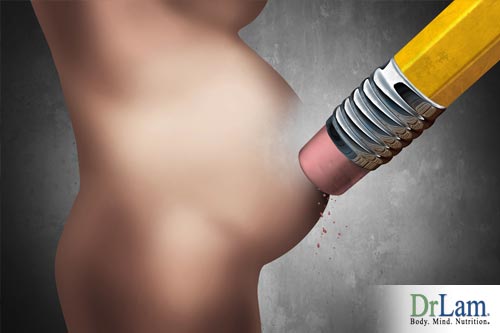
We must understand that a proper reproductive system function program must incorporate plans to ensure that first, hormones are balanced from a natural perspective to allow the body to have all the tools it needs to achieve maximum chance for fertility to begin with ovulation and fertilization. Next is to go through the first trimester with ease by making sure there’s enough progesterone internally. Then, make sure that you have a smooth second and third trimester until delivery. And finally, to make sure that after the delivery, the body still has enough reserves to fall back on so it does not have unrelenting crashes leading to adrenal exhaustion. A complete program, therefore, has to think more comprehensively, not just to patch up the symptoms, but to look at the entire reproductive cycle and the entire process with a comprehensive approach, so that starting very early on, even before pregnancy begins, we can address the PMS endometriosis, and fibrocystic breast, so that a person is well protected throughout.
If you have any of these following symptoms, you have to think of adrenal fatigue syndrome. They include endometriosis, PMS, fibrocystic breast disease, fibroids, irregular menses, PCOS, serial miscarriages during the first trimester, feeling fatigue that is unresolved with thyroid medication, feeling great during pregnancy with all the fatigue reduced, feeling extremely weak and barely making it through in previous pregnancies, excessive fatigue, depression, and postpartum anxiety. There all have underlying adrenal dysfunction, and you would be wise to take care of those things, which is easy enough to do if you have a comprehensive plan to make sure that not only you go through, and the woman go through the pregnancy with great, great results, but also a healthy baby; because we know that an unhealthy mother will lead to an unhealthy baby.
 For the health and benefit of the baby, the mother must be taken care of. The earlier you try to overcome these things to prepare the mother, the better the chance of a healthy baby. For people that you may see that have a lot of this reproductive issue, the strategy is to take a step back, nurture their system back into wholeness for optimal hormonal function, and such a retreat will yield great results for not only pregnancy, but much for a better and healthier family in the future.
For the health and benefit of the baby, the mother must be taken care of. The earlier you try to overcome these things to prepare the mother, the better the chance of a healthy baby. For people that you may see that have a lot of this reproductive issue, the strategy is to take a step back, nurture their system back into wholeness for optimal hormonal function, and such a retreat will yield great results for not only pregnancy, but much for a better and healthier family in the future.
The four-step approach, therefore, requires optimization of the adrenal function to normalize the OAT axis imbalance and neutralize estrogen dominance, making sure that the body is hormonally optimized without stimulants during the first trimester, building the adrenal reserve throughout pregnancy in preparation for a smooth delivery, and making sure, that the postpartum adrenal support is there so that there’s no postpartum fatigue and adrenal crashes. Throughout these natural support programs, a qualified conventional OB/GYN doctor’s understanding and cooperativeness are beneficial as well.
Disruption of reproductive system function is a very important topic that affects many women who are having difficulty with pregnancy. If they are in careers that are very demanding or if they have a Type A personality that’s on the go all the time, the price that they pay for a disruptive body hormonally is very long term and is very severe, and most people, unfortunately, take it for granted until it’s too late. I hope that the alert signs are there; watch out for them, and try to support the body and allow the body to heal itself, and because most of these reproductive problems actually happen in relatively younger women, in their mid-20s or in their mid-30s, the chances for recovery are actually very good, if the proper steps are taken. Furthermore, another alert is to make sure that you do not overstimulate the body, because during these times, even though it may have some temporary benefit, overstimulation is usually a failure in the long term.
If you think that you are in, or have symptoms of Adrenal Fatigue and pregnancy disruptions, recovery needs to be personalized. An improper approach to recovery can complicate, deter, or even exacerbate your current state.
This diet is based on a certain protein found in all foods call lectin, and how this lectin reacts to the blood that is specific for each blood type. While you are young, you may not feel anything. But as your body starts aging, chronic diseases may start. Blood Type O recommends that a person eats more meat or high protein, if you have been vegetarian all your life, your digestive system may not be able to handle the amount of meat the diet recommends. So you may want to slowly ease into the diet.
"I would like to thank you"
"I would like to thank you for your informative web site, you learn far more from yours than you would going several doctors."